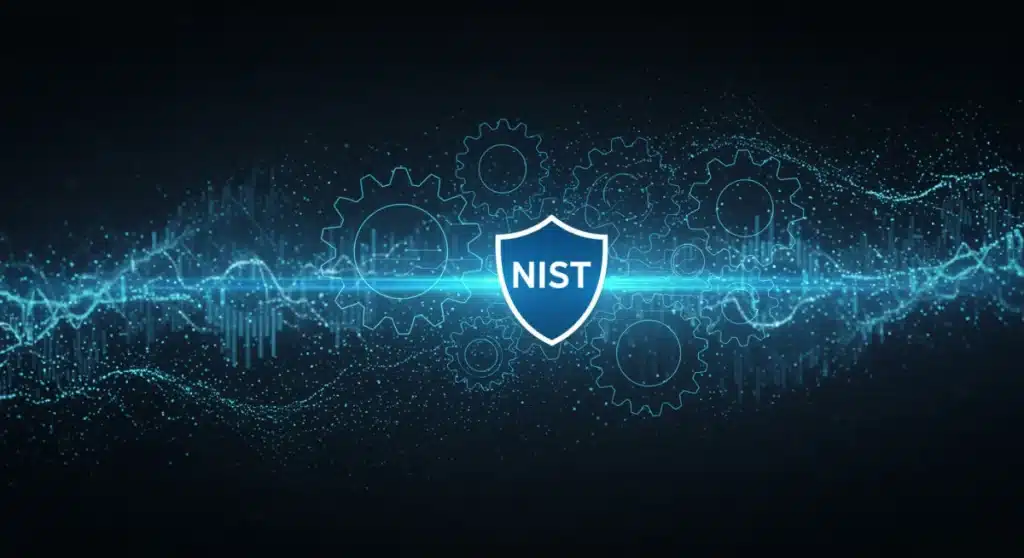NIST Framework Updates 2025: Fintech Compliance Guide

The 3 latest NIST framework updates for 2025 are critical for US fintechs aiming for 90% compliance, offering revised guidelines to bolster cybersecurity postures and mitigate financial penalties.
As the digital financial landscape continues its rapid evolution, staying abreast of regulatory changes is not merely good practice but an absolute necessity. For US fintechs, navigating the complex world of cybersecurity compliance can be particularly challenging. The upcoming NIST framework updates for 2025 are set to redefine industry standards, presenting both challenges and unparalleled opportunities for companies to strengthen their security posture and avoid costly penalties. Understanding these revisions is paramount for achieving and maintaining a high level of compliance.
understanding the critical role of NIST in fintech security
The National Institute of Standards and Technology (NIST) plays a foundational role in defining cybersecurity best practices across various sectors, including the dynamic fintech industry. Its frameworks, though voluntary, are widely adopted and often serve as the de facto standard for regulatory bodies and industry benchmarks. For fintechs, the NIST Cybersecurity Framework (CSF) provides a flexible and comprehensive guide to managing and reducing cybersecurity risks. This framework helps organizations understand, manage, and express their cybersecurity risk in a way that is understandable to both technical and non-technical stakeholders.
The importance of adhering to NIST guidelines cannot be overstated. Beyond simply avoiding penalties, a robust cybersecurity framework built on NIST principles fosters trust among customers and partners, protects sensitive financial data, and ensures operational resilience. In an era where data breaches can lead to catastrophic financial and reputational damage, NIST provides a structured approach to proactive risk management.
the evolution of NIST frameworks for financial services
NIST frameworks are not static; they evolve continually to address emerging threats and technological advancements. This adaptive nature makes them particularly relevant for the fast-paced fintech sector, which is constantly innovating and, by extension, introducing new vulnerabilities. Early iterations focused on foundational security controls, while newer versions emphasize integration with enterprise risk management and supply chain security. The upcoming 2025 updates reflect a deeper understanding of the interconnectedness of modern financial ecosystems.
- Continuous Improvement: NIST frameworks encourage an iterative approach to cybersecurity, recognizing that threats and technologies are always changing.
- Risk-Based Approach: They prioritize risks based on an organization’s specific context, allowing fintechs to allocate resources effectively.
- Interoperability: Designed to work with other compliance standards and regulations, NIST helps streamline the overall compliance burden.
The ultimate goal of NIST is to provide a common language and methodology for cybersecurity, enabling organizations to communicate their security posture effectively and make informed decisions. For US fintechs, this means a clearer path to not only achieving but also demonstrating compliance, which is invaluable in a highly regulated environment.
NIST CSF 2.0: enhancing governance and supply chain risk
One of the most anticipated updates for 2025 is the full integration of NIST CSF 2.0, which introduces significant enhancements, particularly in the areas of governance and supply chain risk management. While the core functions of Identify, Protect, Detect, Respond, and Recover remain central, CSF 2.0 adds a sixth function: Govern. This new function emphasizes the critical role of organizational governance in cybersecurity risk management, ensuring that cybersecurity is treated as an enterprise-wide concern, not just an IT issue.
For fintechs, this means a more formalized approach to how cybersecurity decisions are made, communicated, and integrated into the overall business strategy. It requires executive-level involvement and clear accountability, moving cybersecurity from a technical function to a strategic imperative. The ‘Govern’ function addresses the need for organizations to establish and monitor their cybersecurity strategy, expectations, and policies.
strengthening supply chain cybersecurity
Another major focus of CSF 2.0 is the heightened emphasis on supply chain cybersecurity risk management. Fintechs often rely on a complex ecosystem of third-party vendors, cloud providers, and other partners, each introducing potential vulnerabilities. A single weak link in this chain can expose an entire organization to significant risks. CSF 2.0 provides more granular guidance on identifying, assessing, and mitigating these risks.
- Vendor Due Diligence: Enhanced requirements for vetting third-party providers, including their security controls and compliance postures.
- Contractual Obligations: Clearer expectations for incorporating cybersecurity requirements into contracts with suppliers.
- Continuous Monitoring: Recommendations for ongoing assessment of third-party security performance, not just at the onboarding stage.
By strengthening governance and supply chain risk management, NIST CSF 2.0 aims to provide fintechs with a more holistic and resilient cybersecurity framework. Achieving 90% compliance will require a deep dive into existing governance structures and a thorough re-evaluation of third-party risk management practices.
NIST SP 800-53 revision 5: a comprehensive control catalog
NIST Special Publication 800-53, Revision 5, often referred to as the ‘security and privacy controls for information systems and organizations,’ is another cornerstone update that will significantly impact US fintechs. While CSF provides the high-level framework, SP 800-53 offers a detailed catalog of controls that organizations can implement to achieve their cybersecurity objectives. Revision 5 introduces a more integrated approach to security and privacy, recognizing that these two domains are intrinsically linked.
This revision moves away from a purely system-centric view to an organization-wide perspective, making the controls more adaptable to diverse technology environments, including cloud-based and mobile platforms prevalent in fintech. It also emphasizes the importance of tailoring controls to specific organizational risks and operational needs, rather than adopting a one-size-fits-all approach. This flexibility is crucial for fintechs, which often operate with unique business models and technological infrastructures.
integrating privacy into security controls
A key differentiator of Revision 5 is its explicit integration of privacy controls. In the past, privacy was often treated as a separate or secondary concern, but increasing data protection regulations (like CCPA and potential federal privacy laws) make this integration essential. For fintechs handling vast amounts of sensitive personal and financial data, this means not only protecting data from breaches but also ensuring its ethical and compliant use and management.
- Privacy by Design: Encourages incorporating privacy considerations from the outset of system and product development.
- Data Minimization: Controls that support collecting and retaining only necessary personal information.
- Transparency and Consent: Guidelines for informing individuals about data collection practices and obtaining appropriate consent.
The updated SP 800-53 provides a robust set of security and privacy controls that, when properly implemented, can significantly enhance a fintech’s compliance posture. Achieving 90% compliance will involve a detailed mapping of existing controls against the expanded catalog and identifying areas for enhancement, particularly in privacy-related domains.
NIST SP 800-171 revision 3: protecting controlled unclassified information
NIST SP 800-171, Revision 3, focuses specifically on protecting Controlled Unclassified Information (CUI) in non-federal information systems and organizations. While primarily aimed at contractors working with the federal government, its principles and controls are highly relevant for fintechs, especially those engaging with government agencies or handling data that might be classified as CUI. The financial sector often intersects with government operations, making this revision a critical consideration for many fintech players.
Revision 3 builds upon previous versions by clarifying requirements, enhancing control families, and providing more robust guidance for implementation. It recognizes the increasing sophistication of cyber threats targeting CUI and aims to provide a stronger defense against such attacks. For fintechs, understanding whether they handle CUI and, if so, how to adequately protect it, is a vital step toward comprehensive compliance.

expanded scope and stricter enforcement
The updated SP 800-171 is expected to broaden the scope of what constitutes CUI and to introduce stricter enforcement mechanisms. This means that fintechs previously unaffected by these guidelines might now find themselves needing to comply. The focus remains on safeguarding sensitive information that is not classified but requires protection under various laws, regulations, and government-wide policies.
- Enhanced Access Control: Stricter requirements for managing and monitoring access to CUI, both physical and logical.
- Incident Response Planning: More detailed guidance on developing and testing incident response plans specifically for CUI breaches.
- Security Awareness Training: Increased emphasis on training personnel about their responsibilities in protecting CUI.
Adherence to SP 800-171 Revision 3 is not just about meeting contractual obligations; it is about demonstrating a commitment to safeguarding sensitive information, a principle that resonates deeply within the financial industry. Fintechs aiming for a high level of compliance must assess their data holdings for CUI and implement the necessary controls to meet these evolving standards.
strategic implementation: achieving 90% compliance
Achieving 90% compliance with the latest NIST framework updates for 2025 is an ambitious yet attainable goal for US fintechs. It requires a strategic and systematic approach that goes beyond mere checkbox compliance. The key lies in integrating these frameworks into the very fabric of the organization’s risk management and operational processes. This involves a top-down commitment from leadership and a bottom-up engagement from all employees.
The first step is a comprehensive gap analysis, comparing current security practices against the requirements of CSF 2.0, SP 800-53 Revision 5, and SP 800-171 Revision 3. This analysis will highlight areas of strength and, more importantly, identify specific deficiencies that need to be addressed. Following this, a detailed remediation plan should be developed, prioritizing high-risk areas and leveraging existing resources effectively.
leveraging technology and expertise
Technology plays a crucial role in facilitating compliance. Fintechs should invest in robust security tools, including advanced threat detection, identity and access management solutions, and data loss prevention technologies. Automation can streamline compliance processes, reduce human error, and provide continuous monitoring capabilities. However, technology alone is not sufficient; human expertise is equally vital.
- Dedicated Compliance Teams: Establishing or empowering teams with specialized knowledge in NIST frameworks and fintech regulations.
- Employee Training: Regular and comprehensive cybersecurity awareness training for all staff, tailored to their roles and responsibilities.
- External Audits and Consulting: Engaging third-party experts to conduct independent assessments and provide guidance on complex compliance issues.
By strategically implementing these updates, fintechs can not only achieve high levels of compliance but also build a resilient and trustworthy operation that is well-prepared for future challenges. The investment in compliance is an investment in the long-term viability and success of the business.
avoiding penalties: the cost of non-compliance
The implications of non-compliance with cybersecurity standards, particularly those set by NIST, extend far beyond reputational damage. For US fintechs, regulatory penalties can be severe, ranging from hefty fines to operational restrictions and even loss of licenses. Regulators are increasingly scrutinizing the cybersecurity postures of financial institutions, and a failure to meet established benchmarks can trigger significant enforcement actions.
Beyond direct fines, non-compliance can lead to a cascade of indirect costs. Data breaches, often a direct consequence of inadequate security controls, can result in expensive legal battles, class-action lawsuits, and mandatory notification costs. The erosion of customer trust can lead to significant customer churn, impacting revenue and market share. Furthermore, the operational disruption caused by a cyber incident can halt business activities, leading to further financial losses.
proactive measures for risk mitigation
The best strategy for avoiding penalties is a proactive one. This means not waiting for an audit or an incident to occur before addressing compliance gaps. Continuous monitoring, regular security assessments, and prompt remediation of identified vulnerabilities are essential. Fintechs should also maintain detailed documentation of their compliance efforts, demonstrating due diligence and a commitment to cybersecurity best practices.
- Regular Risk Assessments: Conducting periodic assessments to identify and evaluate new and existing cybersecurity risks.
- Incident Response Drills: Practicing incident response plans to ensure preparedness and minimize the impact of potential breaches.
- Legal and Regulatory Counsel: Engaging with legal experts specializing in fintech and cybersecurity to stay informed about evolving regulatory landscapes.
By understanding the severe financial and operational consequences of non-compliance, US fintechs are strongly incentivized to prioritize and invest in robust cybersecurity programs aligned with the latest NIST framework updates. This proactive approach not only avoids penalties but also positions the organization as a secure and reliable player in the financial services ecosystem.
| Key Update | Impact on US Fintechs |
|---|---|
| NIST CSF 2.0 | Introduces ‘Govern’ function and enhanced supply chain risk management, requiring strategic cybersecurity integration. |
| NIST SP 800-53 Rev. 5 | Comprehensive security and privacy controls, emphasizing integration and tailored risk management. |
| NIST SP 800-171 Rev. 3 | Focuses on protecting Controlled Unclassified Information (CUI) with expanded scope and stricter enforcement. |
| Overall Goal | Achieve 90% compliance, enhance cybersecurity posture, and avoid significant regulatory penalties. |
frequently asked questions about NIST updates
NIST CSF 2.0 introduces a new ‘Govern’ function, emphasizing the strategic integration of cybersecurity into organizational governance. This ensures that cybersecurity is viewed as an enterprise-wide concern, with clear leadership involvement and accountability for risk management decisions across the fintech company.
SP 800-53 Revision 5 significantly integrates privacy controls directly into security measures. For fintechs, this means a more holistic approach to protecting sensitive data, ensuring compliance with privacy regulations like CCPA, and promoting practices such as privacy by design and data minimization from the outset of operations.
While primarily for federal contractors, SP 800-171 Revision 3 is crucial for fintechs handling Controlled Unclassified Information (CUI). This includes data shared with government agencies or sensitive information requiring specific protection. The update broadens its scope and tightens enforcement, making it relevant for a wider range of fintech operations.
Achieving 90% compliance presents challenges like complex third-party ecosystems, rapid technological advancements, and the need for continuous adaptation. Fintechs must conduct thorough gap analyses, invest in robust security tools, and foster a culture of cybersecurity awareness to overcome these hurdles effectively and maintain adherence.
Non-compliance can lead to severe penalties, including substantial regulatory fines, operational restrictions, and legal liabilities from data breaches. Beyond direct financial costs, it can significantly erode customer trust, damage brand reputation, and cause severe business disruption, impacting long-term viability in the competitive fintech market.
conclusion
The landscape of cybersecurity is ever-changing, and the upcoming NIST framework updates for 2025 underscore the critical need for US fintechs to remain vigilant and proactive. By strategically addressing the enhancements in CSF 2.0, SP 800-53 Revision 5, and SP 800-171 Revision 3, fintech companies can not only achieve a remarkable 90% compliance rate but also fortify their defenses against an increasingly sophisticated threat environment. This commitment to robust cybersecurity, guided by NIST principles, is more than a regulatory obligation; it is a foundational pillar for building trust, ensuring operational resilience, and securing a competitive edge in the dynamic financial technology sector. Proactive engagement with these updates will undoubtedly differentiate leading fintechs, safeguarding their operations and their customers’ invaluable data.





